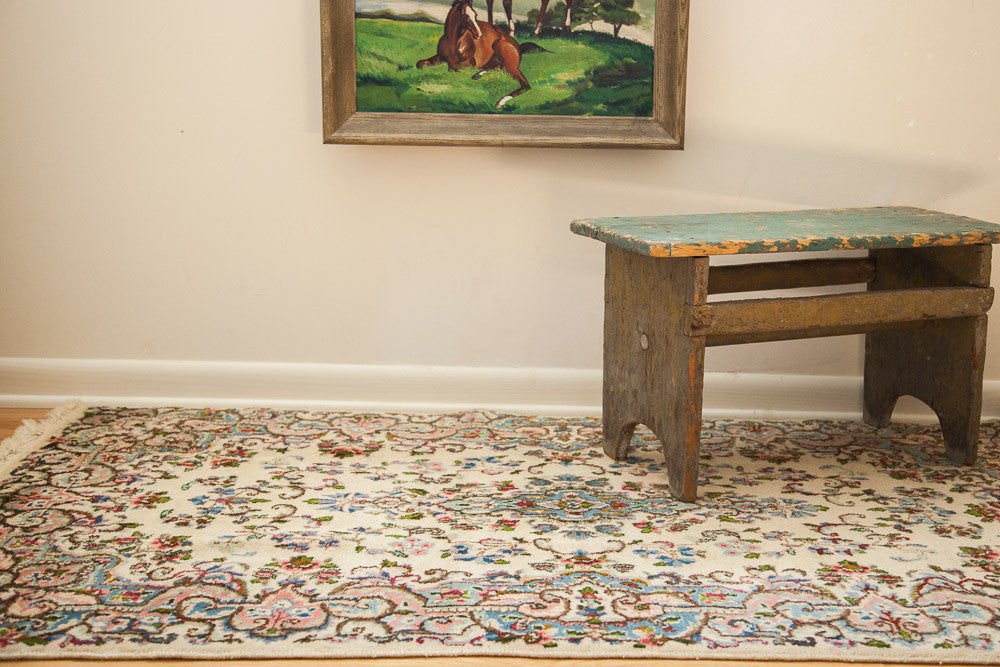
Your guide to purchasing an Oriental Rug
In no specific order - the 4C's and a Q of rugs: Country of origin, Colors, Condition, Collector appeal and Cuality... oops... Quality.
Evaluation of rugs taking in account the above factors means you are on the road to finding a fine, genuine & authentic Oriental rug. That's fantastic!
Part of the beauty of our shop is we have done the legwork of finding only awesome carpets for you: As opposed to the traditional rug shop that may take the good with the bad, we have scouted and sift through thousands of carpets to hand select the ones we love. Yes, here's that shameless plug of our awesome Oriental Rugs for sale. We don't feel too bad about it since we take great pride our rugs, especially our vintage rugs and antique rugs.
As a brief introduction for the consumer, we're going to indulge in a few acceptable generalizations for an overview. It will be important to bear in mind the following: The market for fine hand knotted Oriental rugs is becoming more like fine art. An antique rug made 100+ years ago is not easily replaced since it cannot be remade again. Furthermore, new carpets today are becoming increasingly more costly to produce. Still, in our opinion, Oriental rugs are among the most depreciated markets right now. The sale of museum worthy carpets continues to hit record prices, however, Oriental rugs that are not top-tier museum carpets remain among the most affordable of all decorative items in the context of a home.
That's not to say everyone should run and buy an Oriental rug immediately or as an investment. However, it is relevant for buyers to know and understand where the value is and the clear relative affordability even for a seemingly higher priced item. The process of making an Oriental rug is an intimate task. One could easily take the position the value in an Oriental rug is disproportionately greater than many home furnishings: the typical weaving time of an 8' x 10' Oriental carpet may take two weavers six months time.
While some aspects of evaluation are discussed in what to look for and what is myth, the point remains that any Oriental rug by intrinsic character/definition has been created via a laborious process from materials to loom to room.
So, lets get down to buying a rug and demystifying some of the mystique. What to look for, what is true and what is myth and how to purchase that fantastic, authentic Oriental rug:
Country of origin
A. General rule of thumb: If you are searching for super authenticity, you may want to consider if the design is indigenous to the country of origin and perhaps even region of production. E.G. A Turkish Hereke rug design made in China is not as authentic as a Peking design Chinese rug made in China. There certainly are exceptions although for such items it will likely be clear how those items are differentiated with reliable or substantive proof as to how.
B. Simply because a rug or carpet is of Persian origin does not make it superior item than that of any other rug weaving country. E.G. Compare apples to apples.
Color
A. There is a misconception that natural dyes are better than synthetic. This is not necessarily true. There are, however, collector purists who only specialize in carpets of a certain age, generally prior to the advent of synthetic dyes. However, this caliber carpet realistically does not apply to carpets serving day in and day out utility and decorative dividends. Apart from having a laboratory or being certain of a rugs age as pre-1860's, it is practically impossible to differentiate natural vs. synthetic. Consider the example of indigo - the chemical structure of synthetic and natural indigo are identical. Many carpets with advertised natural dyes are typically a fraction natural.
B. Purchase the colors you like. If a very high investment, you may want to consider something less era-specific and more timeless. Tone-on-tone or contrasting colors often endure well long-term. On the other side, carpets given harsh washes to create strong overtones or draw on the appearance of a faux, aged patina are not in the spirit of how the original carpet was woven, and are therefore considered more decorative subject to the volatility of fads. While such carpets may be created with the same techniques as any other carpet, their popularity may drastically vary up and down every few decades as opposed to consistently holding value and only experiencing mild ups and downs of the market.
Condition
A. Today, perhaps more so than in the past, an older carpet exhibiting wear is more acceptable. This is especially the case for non-formal carpets, and perhaps is propelled in part by decorative markets, although there are some other points to consider as well: 1. You cannot make another antique rug! The amount made is fixed: quantity is diminishing and demand is increasing. Fewer carpets in exceptional condition are surfacing on the market. 2. Many believe a rug should look its age. A carpet exhibiting some wear or tattered area tells a story. You can also enjoy it without the concerns one may have with the use of a mint condition antique.
Collector / Decorative Appeal
If you are searching as a collector - the advice we have is buy what you love, buy cautiously, look for timeless colors or tone-on-tone, look for the best-of-type, look for unusual, the rare, the hard-to-find, manageable sizes of typical dimensions, look for transitional connector designs and motifs, look for condition, look for age, look for authenticity. Notice how quality is not included in this... Carpets purchased by collectors are rarely purchased on any single merit of quality and quality alone.
Quality
Quality typically encompasses the following three factors, no one is necessarily more important than the other. However, know as a first time buyer this one costly misconception: Higher knot count is not a function of higher quality. Period.
A. Quality of material input (mainly pile) for type: a fine workshop type carpet such as a Persian Kashan will have fine, soft, long stapled wool. A commercial grade Pakistani Lahore carpet should have a commercial grade wool. If the Persian Kashan had a commercial grade wool, it would be considered lower in the realm of material quality relative to type.
B. Knot Density for type: e.g. the typical Persian Sarouk from 1920-1950 ranges from 100 knots per inch to 180 knots per inch. If a Sarouk of 180 knots is being compared the range of other Sarouk rugs of similar age and type, it would be considered relatively fine.
C. Execution of weave/design. A high quality carpet will exhibit 1. fully optimized the design with knot density to exhibit details and curves. A poor quality carpet will often show a pixelated appearance, or, in some cases, have used too many knots per inch to convey a design which could have been done in a lower quality!
Quality really encompasses the overall carpet inclusive of material input quality, knot density, and design execution all rolled together. A high quality carpet will embody all these characteristics in a high level when compared to others of their type, age, and origin.
In closing, I want to share with you how I would evaluate a sweet carpet we have in our shop, a Persian Rug:
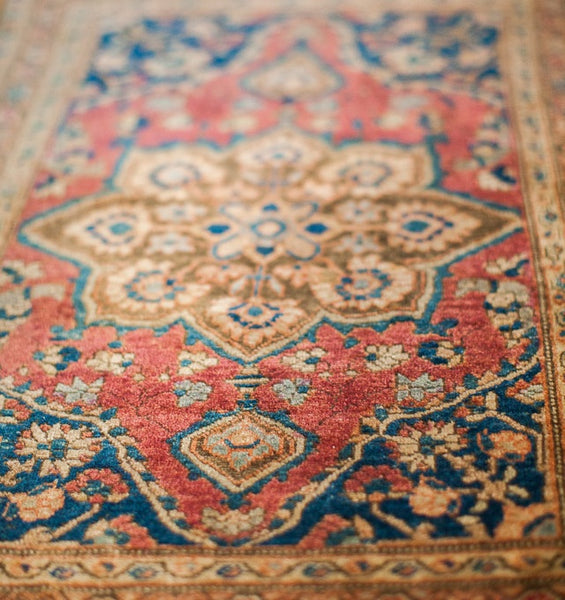
This carpet is one of our personal favorites for several reasons. Going through the 4C's and Q, we're going to get to the bottom of why this piece, as many in our shop, stands out as an awesome carpet on many levels.
Country of origin - It is a Persian rug from Sarouk, specifically of the Sarouk Farahan variety. The design would be considered indigenous to the area woven, as opposed to a far distant adaptation or interpretation of another design. Passing grade!
Colors - Outstanding tone-on-tone in the center medallion and borders. Lovely terra cotta, golds, super soft powder blue, light olive, soft bronze... The colors are all distinguishable yet almost have a hint of analogous shades. The deep blue corner spandrels serve as phenomenal contrast to the whole piece with excellent clarity, character and harmony. This carpet does have some augmentation to the field color, likely done many years after weaving. This "sign of the time" change does not necessarily detract from the value, and in many ways, adds to the story of the piece. Passing grade!
Condition - The condition shows use, wear and age. However, carpets such as this were meant to be used, and often were subjected to more harsh wear than room size carpet. Fewer small pieces seem to survive unless intended as saddle bags, throws or pillow covers. Relatively speaking, the condition concerns are minimal, and the carpet has had no significant restorations so it is all original. Passing grade!
Collector Appeal - Great manageable size, excellent individual character, good age. Condition could be better, but relatively speaking, it is certainly a desirable carpet. Passing grade!
Quality - Outstanding, long staple wool. Super soft and supple. Knot density is in the top of its type and age. The design execution is awesome - stunning, beautiful, classic and timeless with wonderful detail in the minor borders all the way though to the field with delicate, single knot tendrils lacing the ground. All-in-all, a really nice surviving example! Passing grade!
Old New House
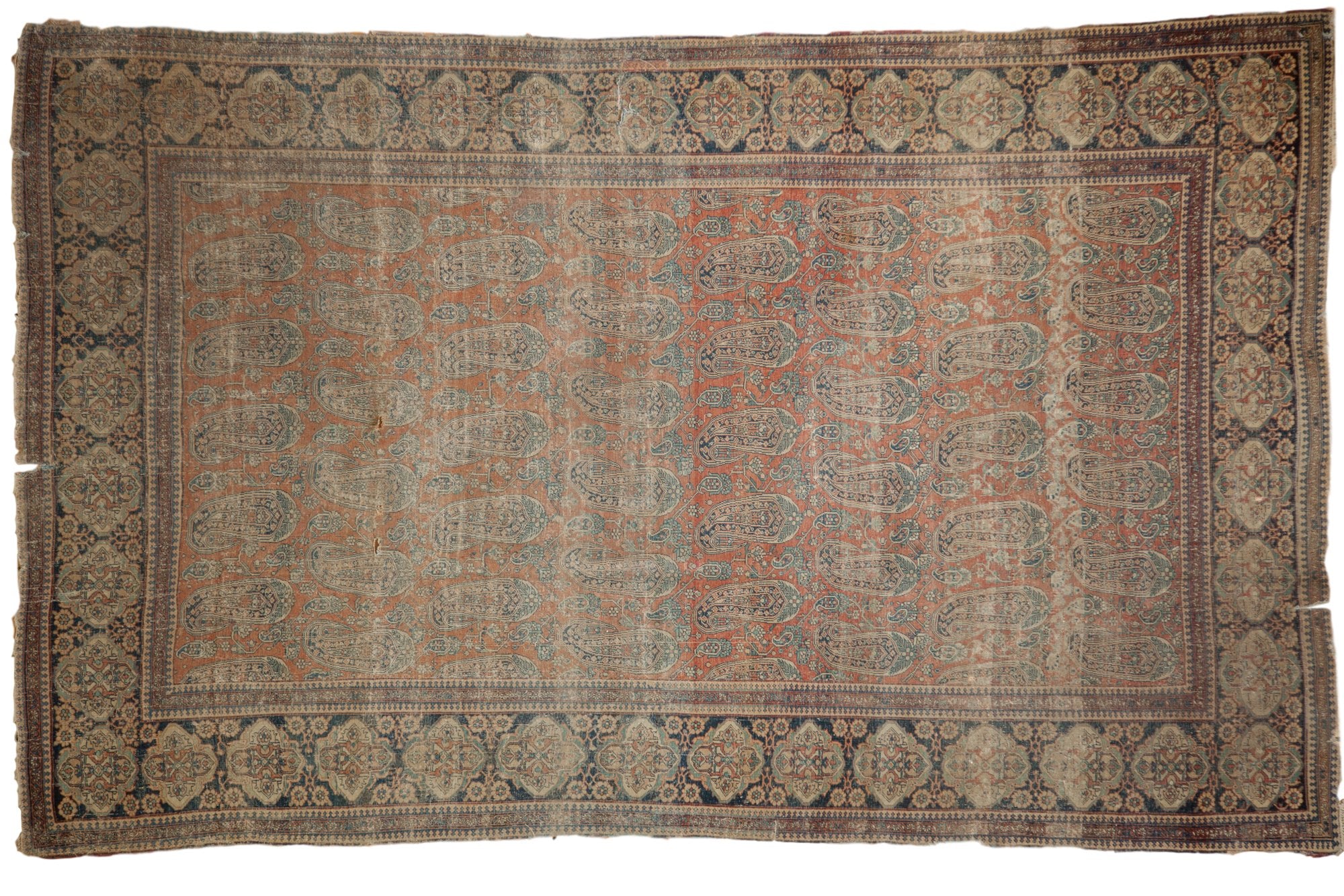 An antique Belouch rug
An antique Belouch rug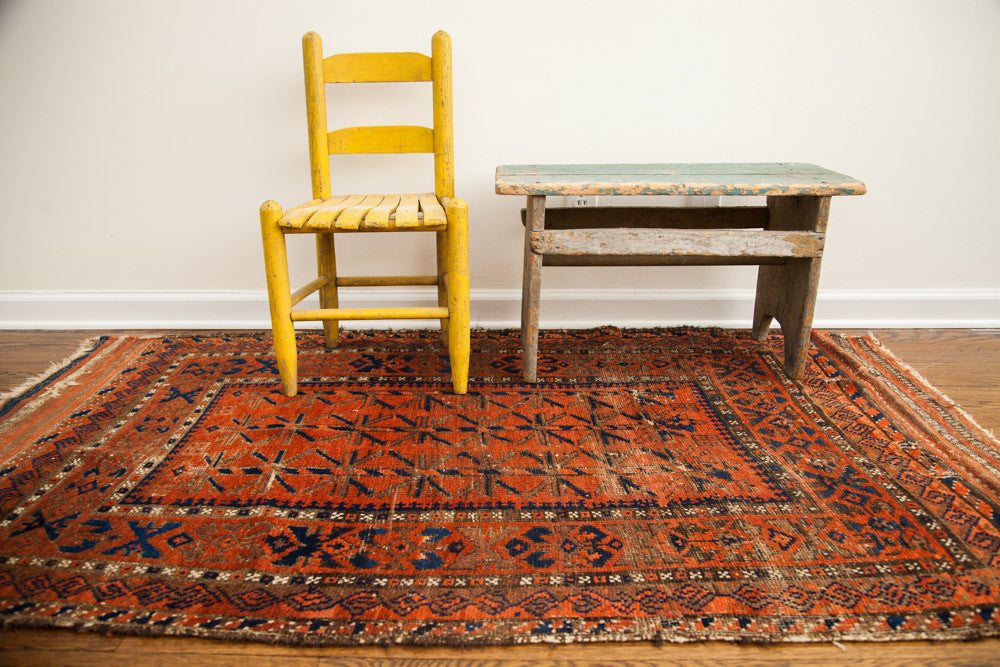 An antique Kerman rug
An antique Kerman rug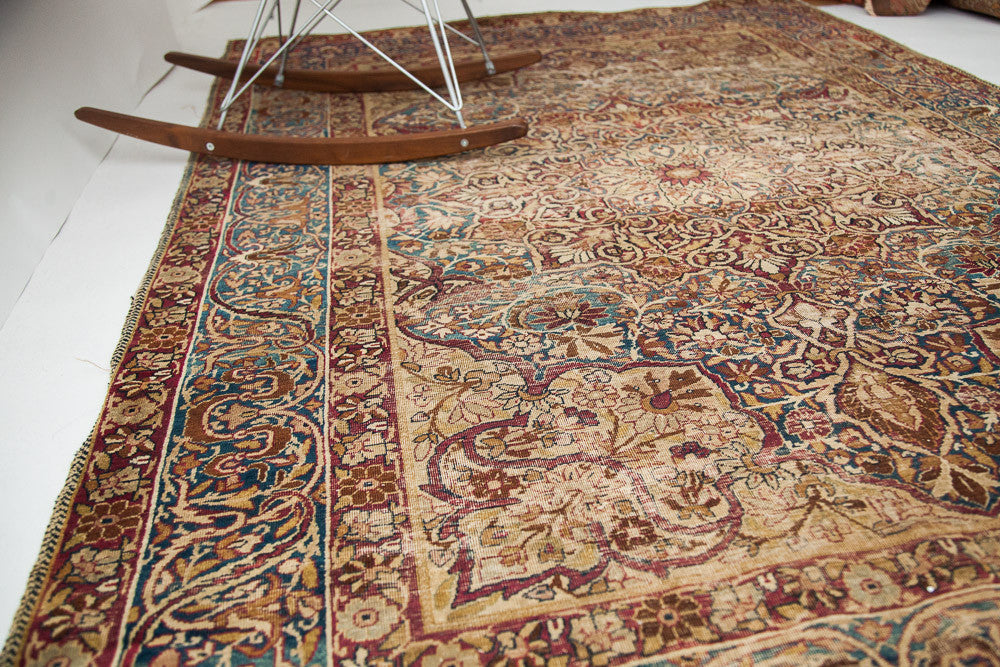
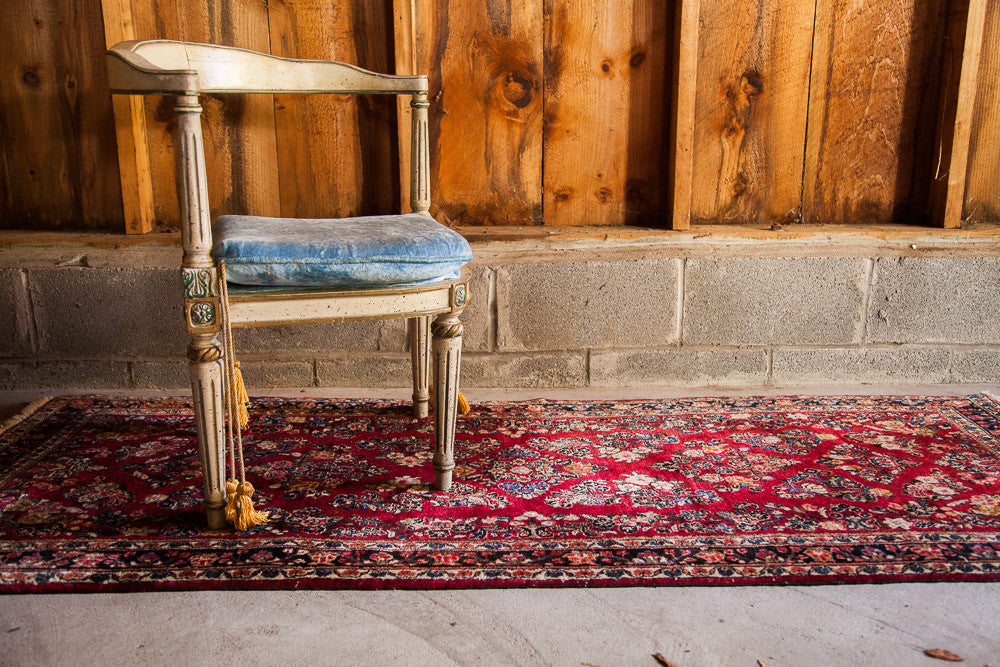 A hard-to-find size rug - a happy vintage Hamadan
A hard-to-find size rug - a happy vintage Hamadan A vintage Kerman rug
A vintage Kerman rug